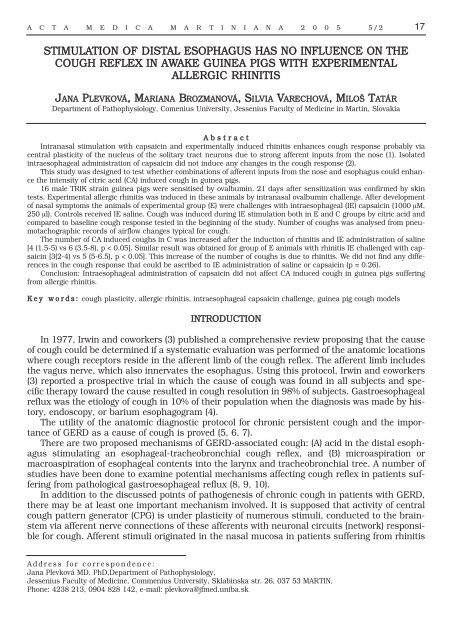MAKETA 5/2 po
MAKETA 5/2 po
MAKETA 5/2 po
Create successful ePaper yourself
Turn your PDF publications into a flip-book with our unique Google optimized e-Paper software.
A C T A M E D I C A M A R T I N I A N A 2 0 0 5 5/2 17<br />
STIMULATION OF DISTAL ESOPHAGUS HAS NO INFLUENCE ON THE<br />
COUGH REFLEX IN AWAKE GUINEA PIGS WITH EXPERIMENTAL<br />
ALLERGIC RHINITIS<br />
JANA PLEVKOVÁ, MARIANA BROZMANOVÁ, SILVIA VARECHOVÁ, MILOŠ TATÁR<br />
Department of Pathophysiology, Comenius University, Jessenius Faculty of Medicine in Martin, Slovakia<br />
A b s t r a c t<br />
Intranasal stimulation with capsaicin and experimentally induced rhinitis enhances cough res<strong>po</strong>nse probably via<br />
central plasticity of the nucleus of the solitary tract neurons due to strong afferent inputs from the nose (1). Isolated<br />
intraesophageal administration of capsaicin did not induce any changes in the cough res<strong>po</strong>nse (2).<br />
This study was designed to test whether combinations of afferent inputs from the nose and esophagus could enhance<br />
the intensity of citric acid (CA) induced cough in guinea pigs.<br />
16 male TRIK strain guinea pigs were sensitised by ovalbumin. 21 days after sensitization was confirmed by skin<br />
tests. Experimental allergic rhinitis was induced in these animals by intranasal ovalbumin challenge. After development<br />
of nasal symptoms the animals of experimental group (E) were challenges with intraesophageal (IE) capsaicin (1000 μM,<br />
250 μl). Controls received IE saline. Cough was induced during IE stimulation both in E and C groups by citric acid and<br />
compared to baseline cough res<strong>po</strong>nse tested in the beginning of the study. Number of coughs was analysed from pneumotachographic<br />
records of airflow changes typical for cough.<br />
The number of CA induced coughs in C was increased after the induction of rhinitis and IE administration of saline<br />
[4 (1.5-5) vs 6 (3.5-8), p < 0.05]. Similar result was obtained for group of E animals with rhinitis IE challenged with capsaicin<br />
[3(2-4) vs 5 (5-6.5), p < 0.05]. This increase of the number of coughs is due to rhinitis. We did not find any differences<br />
in the cough res<strong>po</strong>nse that could be ascribed to IE administration of saline or capsaicin (p = 0.26).<br />
Conclusion: Intraesophageal administration of capsaicin did not affect CA induced cough in guinea pigs suffering<br />
from allergic rhinitis.<br />
K e y w o r d s : cough plasticity, allergic rhinitis, intraesophageal capsaicin challenge, guinea pig cough models<br />
INTRODUCTION<br />
In 1977, Irwin and coworkers (3) published a comprehensive review pro<strong>po</strong>sing that the cause<br />
of cough could be determined if a systematic evaluation was performed of the anatomic locations<br />
where cough receptors reside in the afferent limb of the cough reflex. The afferent limb includes<br />
the vagus nerve, which also innervates the esophagus. Using this protocol, Irwin and coworkers<br />
(3) re<strong>po</strong>rted a prospective trial in which the cause of cough was found in all subjects and specific<br />
therapy toward the cause resulted in cough resolution in 98% of subjects. Gastroesophageal<br />
reflux was the etiology of cough in 10% of their <strong>po</strong>pulation when the diagnosis was made by history,<br />
endoscopy, or barium esophagogram (4).<br />
The utility of the anatomic diagnostic protocol for chronic persistent cough and the im<strong>po</strong>rtance<br />
of GERD as a cause of cough is proved (5, 6, 7).<br />
There are two pro<strong>po</strong>sed mechanisms of GERD-associated cough: (A) acid in the distal esophagus<br />
stimulating an esophageal-tracheobronchial cough reflex, and (B) microaspiration or<br />
macroaspiration of esophageal contents into the larynx and tracheobronchial tree. A number of<br />
studies have been done to examine <strong>po</strong>tential mechanisms affecting cough reflex in patients suffering<br />
from pathological gastroesophageal reflux (8, 9, 10).<br />
In addition to the discussed <strong>po</strong>ints of pathogenesis of chronic cough in patients with GERD,<br />
there may be at least one im<strong>po</strong>rtant mechanism involved. It is sup<strong>po</strong>sed that activity of central<br />
cough pattern generator (CPG) is under plasticity of numerous stimuli, conducted to the brainstem<br />
via afferent nerve connections of these afferents with neuronal circuits (network) res<strong>po</strong>nsible<br />
for cough. Afferent stimuli originated in the nasal mucosa in patients suffering from rhinitis<br />
Address for corres<strong>po</strong>ndence:<br />
Jana Plevková MD, PhD,Department of Pathophysiology,<br />
Jessenius Faculty of Medicine, Commenius University, Sklabinska str. 26, 037 53 MARTIN,<br />
Phone: 4238 213, 0904 828 142, e-mail: plevkova@jfmed.uniba.sk

















